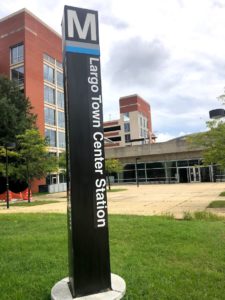“What our ‘On the Wrong Road’ report shows is that the NVTAuthority needs to take a new direction this year. Northern Virginians want to drive less, not more, and based on regional surveys, they also want their leaders to address climate change,” said Stewart Schwartz, CSG Executive Director.
Category: Press Releases
RELEASE: Statement by CSG Executive Director Stewart Schwartz on Gas Prices and Suspension of the Gas Tax
Better, lasting solutions are needed including more sustainable community designs to end our oil dependency
RELEASE: Immigrant Activists Kick Off Pedestrian Safety Campaign at Bailey’s Crossroads 
“Many people living in the Culmore community of Bailey’s Crossroads walk, bike and take the bus to get around but are faced with high-speed traffic, missing sidewalks and a lack of safe crossing options that quickly turn deadly. Now is the time to provide safer streets in Culmore and save lives,” said Sonya Breehey, Northern Virginia Advocacy Manager of Coalition for Smarter Growth.
RELEASE: A Subsidized Washington Commanders Football Stadium is a Bad Deal
Reports indicate Virginia will establish a stadium authority to fund and build a football stadium for the Washington Commanders, to be located in Prince William County or Loudoun County. This is a bad deal in so many ways.

RELEASE: CSG and Immigrant Group CASA Launch Joint Campaign for Safer Streets for Bailey’s Crossroads
Amid an increase in pedestrian and bicyclist deaths and injuries in Fairfax County, with particular risks being faced in some of the county’s immigrant communities, CSG and immigrant advocacy organization CASA are launching the Safe Streets for Bailey’s Crossroads campaign to engage and organize the local community in winning safer streets and improved access to walking, biking and accessing transit and services.

JOINT STATEMENT: Fairfax County’s 13th pedestrian fatality in 2021
The Coalition for Smarter Growth, Fairfax Families for Safe Streets, and Fairfax Alliance for Better Bicycling are urging VDOT to address safety issues along the Leesburg Pike (aka Route 7) in the Bailey’s Crossroads area of Fairfax County after another pedestrian was struck and killed in December.

STATEMENT: CSG Responds to David Lublin of Seventh State
The Coalition for Smarter Growth issued the following statement in response to David Lublin’s Seventh State posts about Jane Lyons, CSG’s Maryland Advocacy Manager

RELEASE: MetroNow Bus Transformation Project Progress Report
In response to the region’s critical transit needs, leading transportation coalition launches the Bus Champions Roundtable, a series of targeted discussions with regional leaders to align priorities and accelerate bus transformation progress.
MetroNow Statement on Blue Line Derailment and Ongoing Service Disruptions
Washington, DC — The MetroNow Coalition—comprised of the Coalition for Smarter Growth, Federal City Council, Greater Washington Board of Trade, Greater Washington Partnership, Northern Virginia Chamber of Commerce, Prince George’s Chamber of Commerce, the 2030 Group, and Tysons Partnership—today released the following statement on the ongoing WMATA Metrorail service disruptions.

